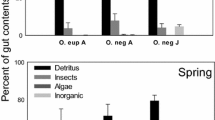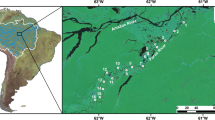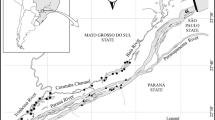Abstract
Increased industrial activities on the Peace and Athabasca River systems have raised concerns about cumulative impacts on fish and water resources downstream, in the Slave River of Alberta and the Northwest Territories, Canada. Because very little information was available on the fish communities in this system, we examined spatial and temporal patterns of diet for nine species (four piscivores and five invertebrate feeders) from three different types of habitat along the lower Slave River system and assessed trophic relationships within the communities. All actively feeding species exhibited seasonal variations in diet within and among the study areas. Dietary overlap was generally low throughout all seasons and locations. In the lower Slave River and its major tributary, the Salt River, substantial dietary overlap between piscivores (particularly walleye, Stizostedion vitreum), and invertebrate feeders occurred in the spring. In the summer no overlap occurred as walleye shifted to a more piscivorous diet, attaining a moderate degree of overlap with northern pike, Esox lucius. Compared with the Slave River, which is a large but homogeneous system upstream of its delta at Great Slave Lake, there was a greater diversity of actively feeding invertebrate feeders in the Salt River. Three of the latter were benthic feeders exhibiting moderate degrees of diet overlap during spring and summer. During the fall, few fish were feeding. Most fishes in the lower Slave River system are generalist, opportunistic feeders, consuming a number of different prey, the importance of which varies spatially and seasonally, as the abundance of these prey varies in the environment.
Similar content being viewed by others
References cited
Alt, K.T. 1969. Taxonomy and ecology of the inconnu, Stenodus leucichthys nelma, in Alaska. Biological Papers of the University of Alaska 12. 63 pp.
Barton, D.R. 1980. Benthic macroinvertebrate communities of the Athabasca River near Fort Mackay, Alberta. Hydrobiologia 74: 151–160.
Barton, D.R. 1986. Invertebrates of the Mackenzie system. pp. 473–492. In: B.R. Davies & K.F. Walker (ed.) The Ecology of River Systems, Dr W. Junk Publishers, Dordrecht.
Bayley, P.B. & M. Petrere, Jr. 1989. Amazon fisheries: assessment methods, current status and management options. pp. 385–398. In: D.P. Dodge (ed.) Proceedings of the International Large River Symposium, Can Spec. Publ. Fish. Aquat. Sci. 106.
Bodaly, R.A., J.D. Reist, D.M. Rosenberg, P.J. McCart & R.E. Hecky. 1989. Fish and fisheries of the Mackenzie and Churchill river basins, northern Canada. pp. 128–144. In: D.P. Dodge (ed.) Proceedings of the International Large River Symposium, Can. Spec. Publ. Fish. Aquat. Sci. 106.
Bodden, K. 1980. The economic use by native people of the resources of the slave River Delta. M.A. Thesis, University of Alberta, Edmonton. 178 pp.
Bryan, S.D., T.D. Hill, S.T. Lynott & W.G. Duffy, 1995. The influence of changing water levels and temperatures on the food habits of walleye in Lake Oahoe, South Dakota. J. Freshwater Ecology 10: 1–10.
Buchwald, D.G. 1968. The Arctic lamprey of Great Slave Lake, NWT. M.Sc. Thesis, University of Alberta, Edmonton. 84 pp.
Burdick, G.E., E.J. Harris, J.H. Dean, T.M. Walker, J.C. Skea & D. Colby. 1964. The accumulation of DDT in lake trout and the effect on reproduction. Trans. Amer. Fish. Soc. 93: 127–136.
Chapman, L.J., W.C. Mackay & C.W. Wilkinson. 1989. Feeding flexibility in northern pike (Esox lucius): fish versus invertebrate prey. Can. J. Fish. Aquat. Sci. 46: 666–669.
Christiansen, D.G. 1976. Feeding and behavior of northern pike (Esox lucius Linnaeus). M.Sc. Thesis, University of Alberta, Edmonton. 302 pp.
Colby, P.J., R.E. McNicol & R.A. Ryder. 1979. Synopsis of biological data on the walleye, Stizostedion v. vitreum (Mitchell 1818). FAO Fisheries Synopsis 119. 139 pp.
Delorme, L. 1991. Ostracoda. pp. 697–699. In: J.H. Thorpe & A.P. Covich (ed.) Ecology and Classification of North American Freshwater Invertebrates, Academic Press, San Diego.
Diana, J.S. 1979. The feeding pattern and daily ration of a top carnivore, the northern pike (Esox lucius). Can. J. Zool. 57: 2121–2127.
Donald, D.B. & A.H. Kooyman. 1977. Food, feeding habits, and growth of goldeye, Hiodon alosoides (Rafinesque), in waters of the Peace-Athabasca Delta. Can. J. Zool. 55: 1038–1047.
Fuller, W.A. 1955. The inconnu (Stenodus leucichthys mackenzii) in Great Slave Lake and adjoining waters. J. Fish. Res. Board Can. 12: 768–780.
George, E.L. & W.F. Hadley. 1979. Food and habitat partitioning between rock bass (Ambloplites rupestris) and smallmouth bass (Micropterus dolomieui) yong of the year. Trans. Amer. Fish. Soc. 108: 253–261.
Graham, J.H., & R.C. Vrijenhoek. 1988. Detrended correspondence analysis of dietary data. Trans. Amer. Fish. Soc. 117: 29–36.
Hill, M.O. & H.G. Gauch. 1980. Detrended correspondence analysis, an improved ordination technique. Vegetatio 42: 47–58.
Hyslop, E.J. 1980. Stomach content analysis — a review of methods and their application. J. Fish Biol. 17: 411–429.
Keast, A. 1978. Trophic and spatial interrelationships in the fish species of an Ontario temperate lake. Env. Biol. Fish. 3: 7–31.
Keast, A. & D. Webb. 1966. Mouth and body form relative to feeding ecology in the fish fauna of a small lake, Lake Opinicon, Ontario. J. Fish. Res. Board Can. 23: 1845–1874.
Kennedy, W.A. & W.M. Sprules. 1967. Goldeye in Canada. Bull. Fish. Res. Board Can. 161. 45 pp.
Lawler, G.H. 1965. The food of pike, Esox lucius, in Heming Lake, Manitoba. J. Fish. Res. Board Can. 22: 1357–1377.
Little, A.S. 1997. Food and habitat use within the fish assemblages of the lower Slave River, Northwest Territories. M.Sc. Thesis, University of Alberta, Edmonton. 117 pp.
Nelson, J.S. & M.J. Paetz. 1972. Fishes of the Northeastern Wood Buffalo National Park Region, Alberta and Northwest Territories. Can. Field-Nat. 86: 133–144.
Novoa, D.F. 1989. The multispecies fisheries of the Orinoco River: development, present status, and management strategies. pp. 422–428. In: D.P. Dodge (ed.) Proceedings of the International Large River Symposium, Can. Spec. Publ. Fish. Aquat. Sci. 106.
Petrova, N.A. 1976. The biology of the inconnu, Stenodus leucichthys nelma, from the Irtysh River Basin. J. Ichthyology 16: 17–27.
Rawson, D.S. 1951. Studies of the fish of Great Slave Lake. J. Fish. Res. Board Can. 8: 207–240.
Roy, D. 1989. Physical and biological factors affecting the distribution and abundance of fishes in rivers flowing into James Bay and Hudson Bay. pp. 159–171. In: D.P. Dodge (ed.) Proceedings of the International Large River Symposium, Can. Spec. Publ. Fish. Aquat. Sci. 106.
Schoener, T.W. 1974. Resource partitioning in ecological communities. Science 185: 27–39.
Scott, W.B. & E.J. Crossman. 1973. Freshwater fishes of Canada. Bull. Fish. Res. Board Can. 184. 966 pp.
ter Braak, C.J.F. 1987. CANOCO — a Fortran program for canonical community ordination by [partial] [detrended] [canonical] correspondence analysis, principal component analysis and redundancy analysis (version 2.1). ITI-TNO Institute of Applied Computer Sciences, Wageningen. 95 pp.
Thomann, R.V. 1989. Bioaccumulation model of organic chemical distribution in aquatic food chains. Env. Sci. Tech. 23: 699–707.
Tohtz, J. 1993. Lake whitefish diet and growth after the introduction of Mysis relicta to Flathead Lake, Montana. Trans. Amer. Fish. Soc. 122: 629–635.
Turner, L.J. 1984. Space and prey use by northern pike (Esox lucius L.) in two Alberta lakes. M.Sc. Thesis, University of Alberta, Edmonton. 179 pp.
Wallace, R.K., JR. 1981. An assessment of diet-overlap indexes. Trans. Amer. Fish. Soc. 110: 72–76.
Wiggins, G.B. (ed.) 1977. Larvae of the North American caddisfly genera (Trichoptera). University of Toronto Press, Toronto. 401 pp.
Author information
Authors and Affiliations
Corresponding author
Rights and permissions
About this article
Cite this article
Little, A.S., Tonn, W.M., Tallman, R.F. et al. Seasonal variation in diet and trophic relationships within the fish communities of the lower Slave River, Northwest Territories, Canada. Environmental Biology of Fishes 53, 429–445 (1998). https://doi.org/10.1023/A:1007433400648
Issue Date:
DOI: https://doi.org/10.1023/A:1007433400648




